Across the country, rows of vines have become battlegrounds. Centuries-old châteaux have been reduced to rubble. But from Odesa to Mykolaiv, small family wineries and historic estates alike are still producing — often under shelling, and always under threat.
In some cases, making wine now means risking your life.
Most of Ukraine’s wine production is concentrated in the southeast of the country — areas that remain regular targets of Russian attacks. Some vineyards are located just a few kilometres from the front line, where the shelling has never stopped.
Today, producing wine means surviving. For those who still have access to their vines, the daily routine has changed dramatically. Alongside pruning, there is now another daily ritual: walking the rows each morning to check whether Russian drones have dropped new mines.
And yet, production continues wherever it can. Several Ukrainian wines have made it all the way to tables across Europe and even the United States. Others, however, are destroyed under the bombs.
MYKOLAÏV REGION
Pavlo Magalias appears on my laptop screen in military uniform — tired, with a serious expression. A video call is the only way to tell the story of Olvio Nuvo, his family-run winery in the Mykolaïv region. Reaching it in person is now impossible: too dangerous.
"The last journalists came two years ago. They ended up under fire too. I didn’t even know how to help them," Pavlo says.
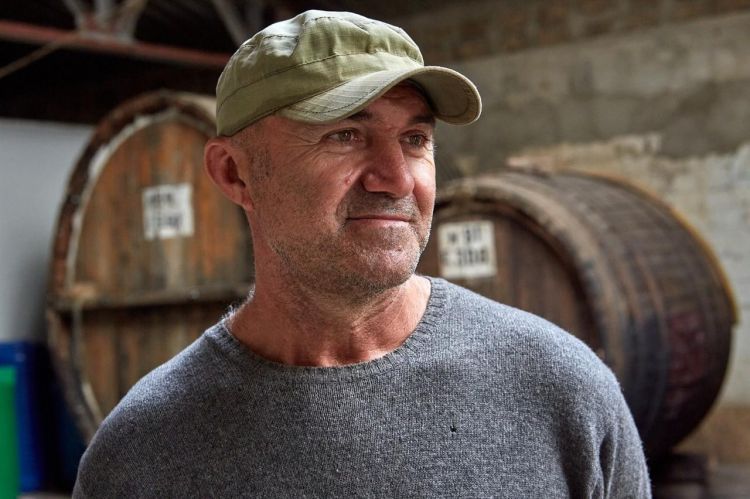
Pavlo Magalias, founder of Olvio Nuvo
The winery stands on the right bank of the Dnipro Estuary. Just across the water — clearly visible to the naked eye — lies the narrow Kinburn Spit, now under Russian control. Their positions are there, beyond the shoreline.
Olvio Nuvo is a small family-run winery, with ten hectares of vineyards that have been under fire for nearly four years.
“At the beginning, they were shelling us with Uragan and Smerch rocket launchers,” Pavlo says. “Now it’s kamikaze drones and ballistic missiles. In one part of the vineyard, fragments of a rocket are still lodged between the rows. In another, the vines were shredded down to the roots by shrapnel”.
Production is centred around six labels, all intended for the domestic market.
There is no scope for exports, nor any opportunity to generate wine tourism. What keeps the winery running are direct orders, mostly from Ukrainian restaurants, while a small portion of the harvest is sold to other producers. Even postal deliveries are limited — sending out a single case means travelling from the countryside to the city, a journey that, in a war zone, can be life-threatening.
“Before the war, we made a good living from wine tourism — tastings, guided tours, small festivals,” Pavlo recalls. “Just a few steps from here lies the archaeological reserve of Olbia, and visitors used to come from all over Ukraine and even from abroad. Now, of course, no one is left — and to be honest, I wouldn’t feel right inviting anyone. It would be like sending them into a Squid Game”.
Among the white grape varieties are Johanniter, Malvasia Bianca, and a rare hybrid called Muscat Citronnyj Magaracha — a cold-resistant cultivar known for its intense, citrusy aromatic profile.
As for reds, Olvio Nuvo works with Odeskyi Chornyi and Bastardo, two local grapes still largely unknown in Western Europe.
“When the war began, our first instinct was to protect the vines,” Pavlo says. “Wine, for us, isn’t just about flavour — it’s identity. It’s our way of saying we’re still here, still resisting”.
Had Pavlo and his wife ever considered leaving it all behind and relocating somewhere safer?
He gives a faint smile. “Yes,” he says. “One day, I left everything. To enlist”.
It was the autumn of 2022. The harvest was done, the wine already in tanks. Pavlo left to join the army — 67th Brigade, company commander. His wife stayed behind, managing the winery alone while he spent fifteen months on the front lines.
After more than a year of military service, he was discharged due to age limits. But coming home did not mean peace.
A former soldier trained in mine clearance, Pavlo — the founder of Olvio Nuvo — returned to his land to face what the war had left behind: vine rows riddled with shrapnel, unexploded ordnance, rocket fragments lodged deep in the soil.
“I lost count of the landmines I’ve found between the rows”, he says.
Returning to winemaking meant something more than just production. It meant demining — quite literally. In 2024, despite everything, the winery launched a new line based on Rkatsiteli, a Georgian grape planted before the invasion.
For the team at Olvio Nuvo, it was like starting from scratch. “A second birth,” as they call it.
THE END OF CHÂTEAU TRUBETSKOY: ONLY FOUR BOTTLES SURVIVED
Where facilities remain intact, winemaking continues. But some estates have been left with nothing — no vines, no buildings, no land to work. “Our vineyards are still mined. The soil is littered with fragments of Russian missiles. The château, a historic building, has been severely damaged and is no longer operational”, says Serhii Parkhomchuk, marketing director of Château Trubetskoy — one of the oldest wineries in Ukraine, founded in the 19th century.
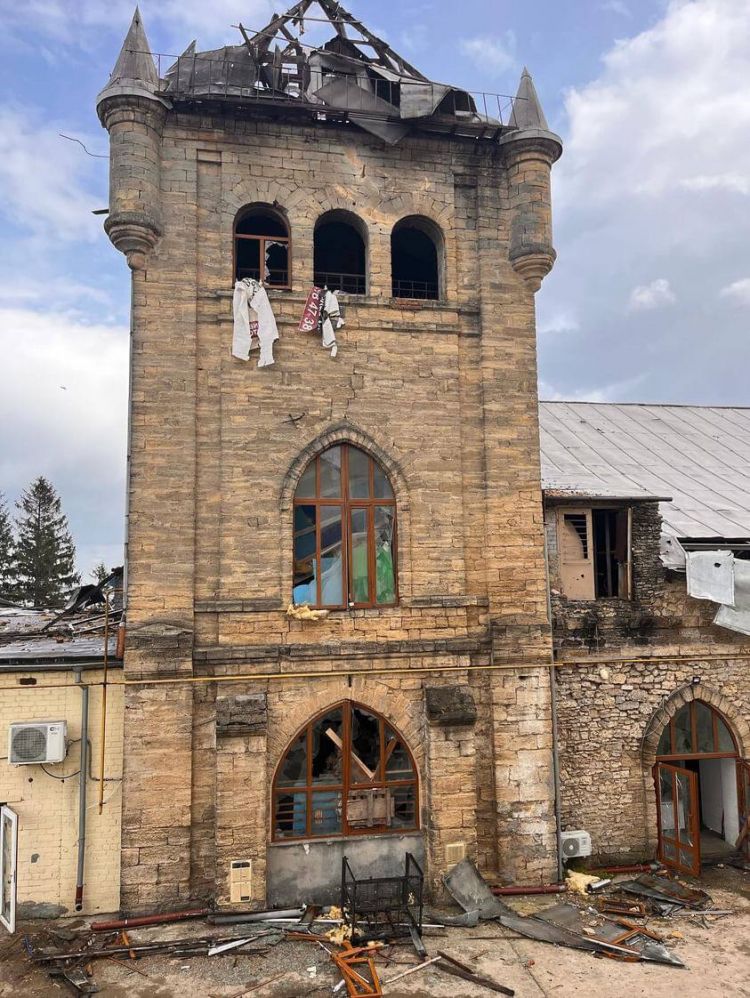
What remains of the historic château after repeated Russian attacks
The Kakhovka hydroelectric power plant no longer exists. The nearest town has been evacuated, its homes either severely damaged or razed to the ground. “It’s practically the front line. Shelling here has never stopped”, Parkhomchuk continues.
Since the start of the Russian invasion and until November 2022, the winery remained under occupation. Everything was looted — not only the equipment, but also a one-of-a-kind collection of wines dating back to 1958, thousands of bottles once intended for future generations.
Today, the vineyards are no longer cultivated. Even the secondary storage facility, located in Hostomel near Kyiv, was hit by rocket shrapnel.
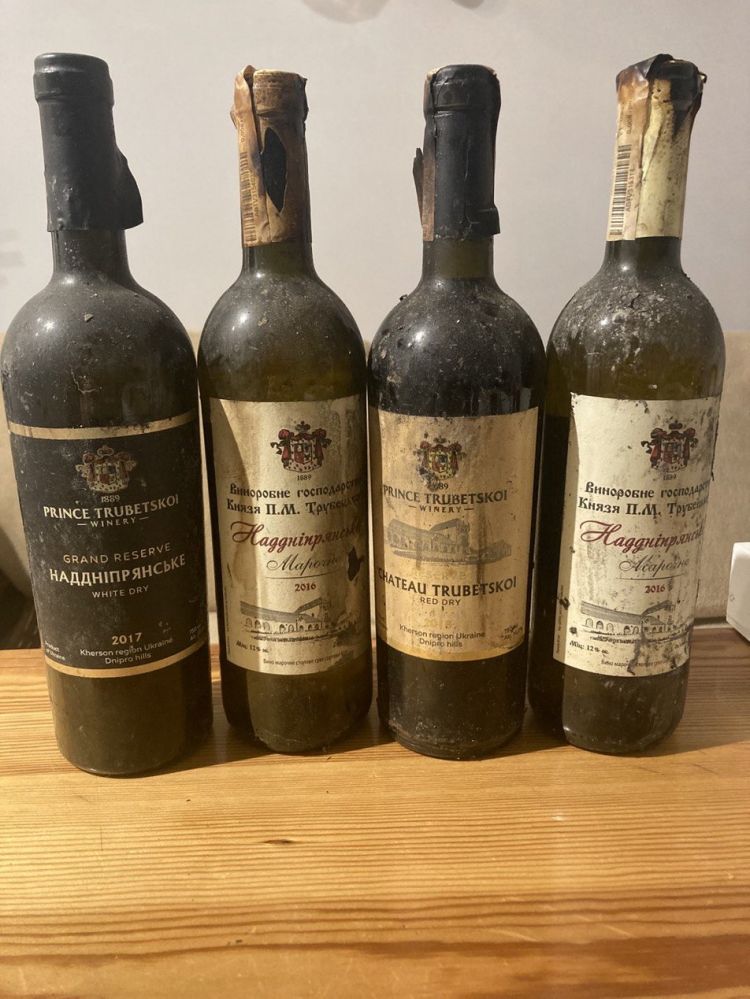
All that’s left: four surviving bottles of Château Trubetskoy
“We used to store around forty thousand bottles under our label”, says Serhii.
“Sadly, only four survived. We tried to buy a few back from shops across the country and managed to recover, at best, a case and a half. The bottles we’ve salvaged will be kept for something special — we hope to display them in a museum one day”.
Over time, the team made another decision: to change the name — a symbolic gesture.
“Prince Trubetskoy? He was the founder, yes. But that name belongs to the empire. It no longer represents who we are,” Serhii explains. That’s how STOIC Winery was born — a complete rebranding.
The château may be gone, but what remains, above all, is the team. The people. And the goal now is to rebuild, to keep moving forward.
In 2024, the new label produced 15,000 bottles, and they’re aiming to maintain that output again this year. For now, the wine is vinified at a partner winery in the Izmail district, near the borders with Romania and Moldova — a relatively safer area, though not immune to attacks.
The whites include Pinot Blanc, Chardonnay, Merlot and Riesling; the reds, Cabernet Franc and Merlot — the same varieties once grown in Trubetskoy’s original vineyards, now part of STOIC’s portfolio.
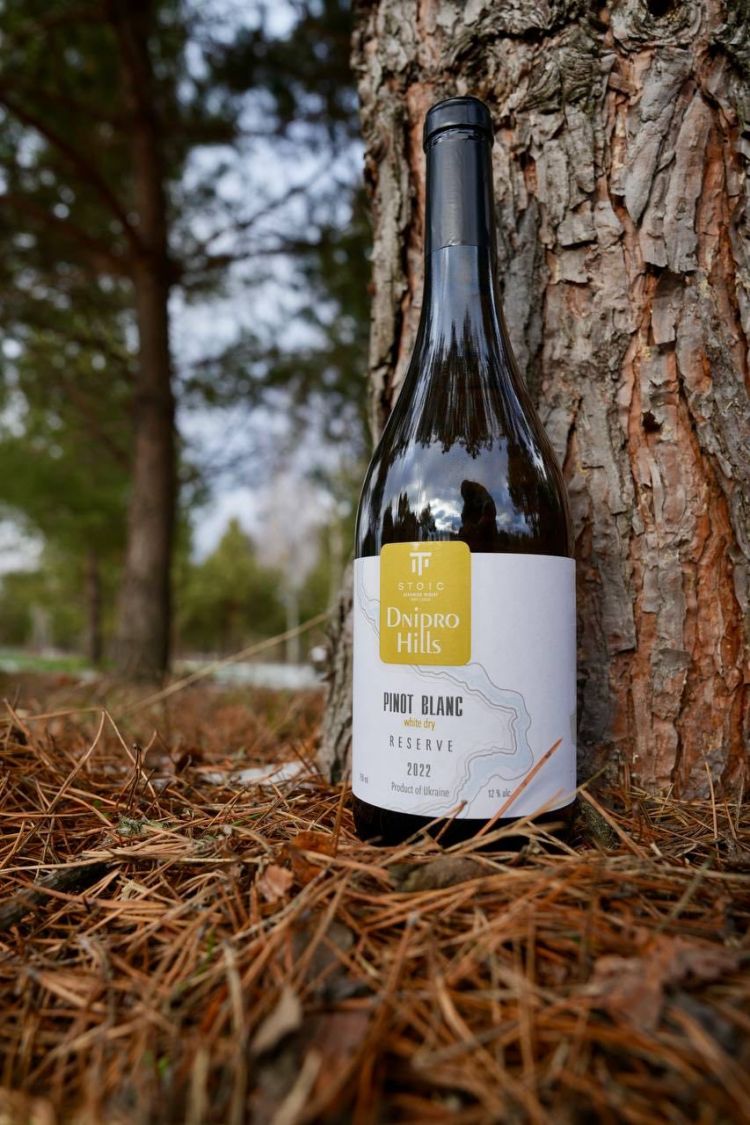
Château Trubetskoy reborn as Stoic Winery
2,500 bottles have already been exported to the United States.
“It’s not just about selling,” they explain. “For us, wine is above all a matter of dignity. After everything that has happened, we want our work to speak beyond Ukraine — to say that we are still here, that we exist, and that we haven’t given up”.
MY WINE: IL SOGNO CHE RESISTE
My Wine, a winery located in Ukraine’s Odesa region, was awarded a silver medal at the 2024 Decanter World Wine Awards in London — one of the most prestigious wine competitions in the world — for its Chardonnay Reserve. Back in 2023, the 2021 vintage Chardonnay had already earned a silver medal at the Mondial des Vins Blancs in Strasbourg. And in 2025, yet another recognition followed: the winery’s Sukholymanskyi White, a rare indigenous grape variety from the same region, won a bronze medal at the Decanter Awards.
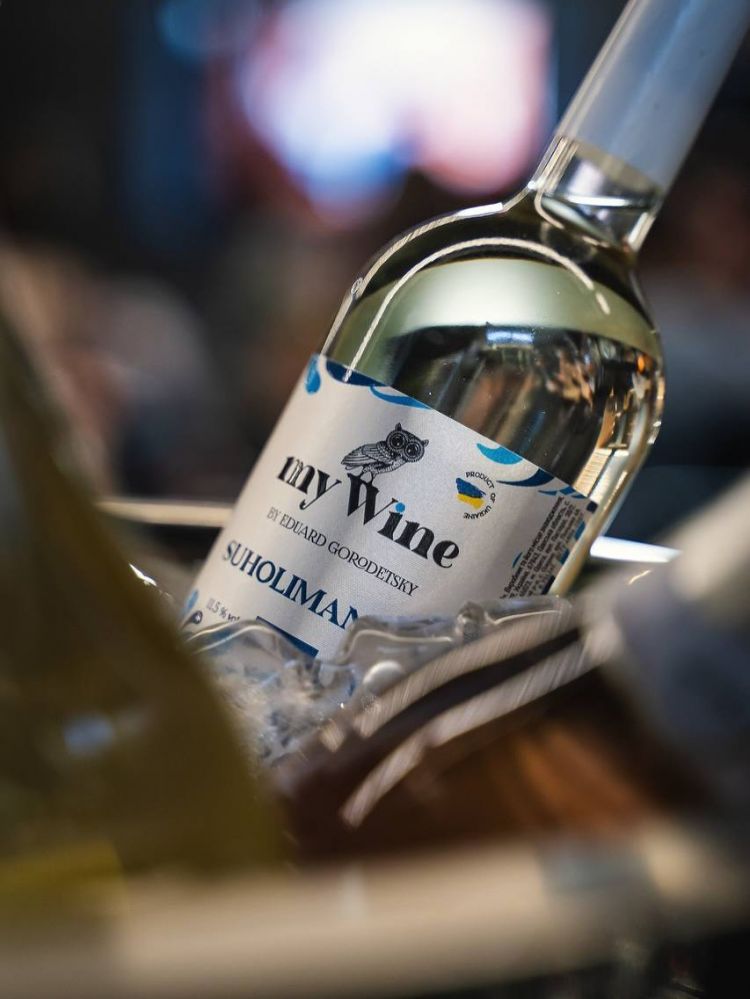
Among several wartime achievements, My Wine also earned a bronze medal at the 2025 Decanter World Wine Awards for its Sukholymanskyi Bianco, a rare indigenous Ukrainian grape
Behind this success, there’s no major industrial conglomerate nor a centuries-old family estate. What you’ll find instead is Eduard Gorodetsky, 45, a young winemaker with a background as a technician and executive in Ukraine’s wine and spirits industry.
“I’m a fourth-generation vintner on my father’s side,” he says, “but I didn’t inherit anything, just a deep love for wine and the skills I picked up on the job”.
For twenty years, Eduard worked at the massive former cognac production plant in Odesa. He rose steadily through the ranks—starting out cleaning barrels, eventually becoming the general director.

Eduard Gorodetsky, founder and winemaker at My Wine
Then, one day, came a bolt of lightning.
“While visiting some wineries in France, I realized that my dream was to create something of my own—something intimate, authentic, real”.
So he quit. He purchased the crumbling remains of an old winery that had been abandoned for more than sixty years and began restoring it. Today, the château is about 70% rebuilt. It’s located in Roksolany, a village steeped in history—once home to the ancient Greek colony of Nikonion, where wine was made as far back as classical antiquity. Even now, it’s not uncommon to find shards of amphorae buried between the vines.
“The place is enchanting—or it would be, if not for the shelling”.
The area is considered high risk. “Russian missiles fall here often. That’s why I haven’t yet found the courage to finish the restoration”.
Today, Eduard produces his wines in a rented facility owned by friends, still located in the Odesa region. He doesn’t yet have vineyards of his own, but he works with both international and local grape varieties: Chardonnay, Pinot Noir, Cabernet, and Merlot, alongside native Ukrainian grapes such as Odeskyi Chornyi and Sukholymanskyi. And then, a personal tribute: Rkatsiteli — the Georgian grape introduced to Ukraine by his father.
“In 2024, we launched a brand new line based entirely on Rkatsiteli,” he says. Today, My Wine bottles reach as far as Japan, Denmark, and Estonia. Eduard has three children, and before the war, his eldest — now ten — used to follow him everywhere: to harvests, to the cellar, to every step of the winemaking process. These days, that closeness is no longer possible.
“When the Russian invasion began, I took the kids to Moldova. Later, they moved to Spain. But I don’t want to live anywhere else. I just want to stay here, in Ukraine, and make my wine. Hopefully, one day, with my son by my side”. It’s a determination that endures, despite fear. “Of course I feel terrified sometimes. But this is my life, my dream, my land.”
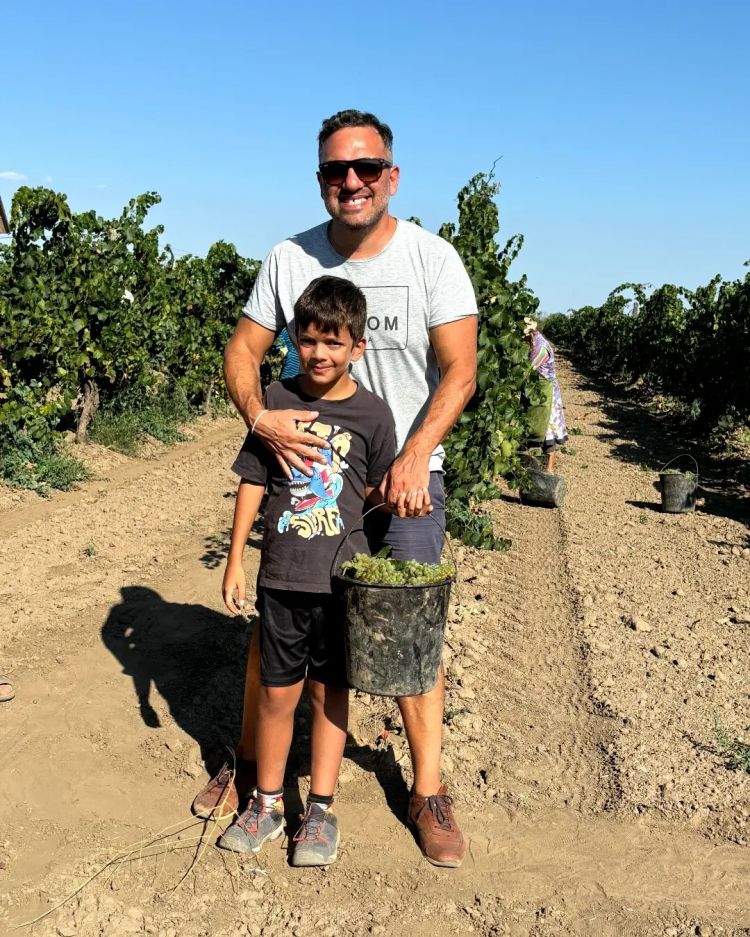
Eduard Gorodetsky and his son, once inseparable in the vineyard
In Ukraine, wine continues to be born, even as those who make it risk dying among the vines. It’s not just production. It’s daily resistance. A stubborn will to stay, to cultivate, to pass something on.
And if one day you come across a Ukrainian label, remember: it was made by someone who loves winemaking more than their own life.